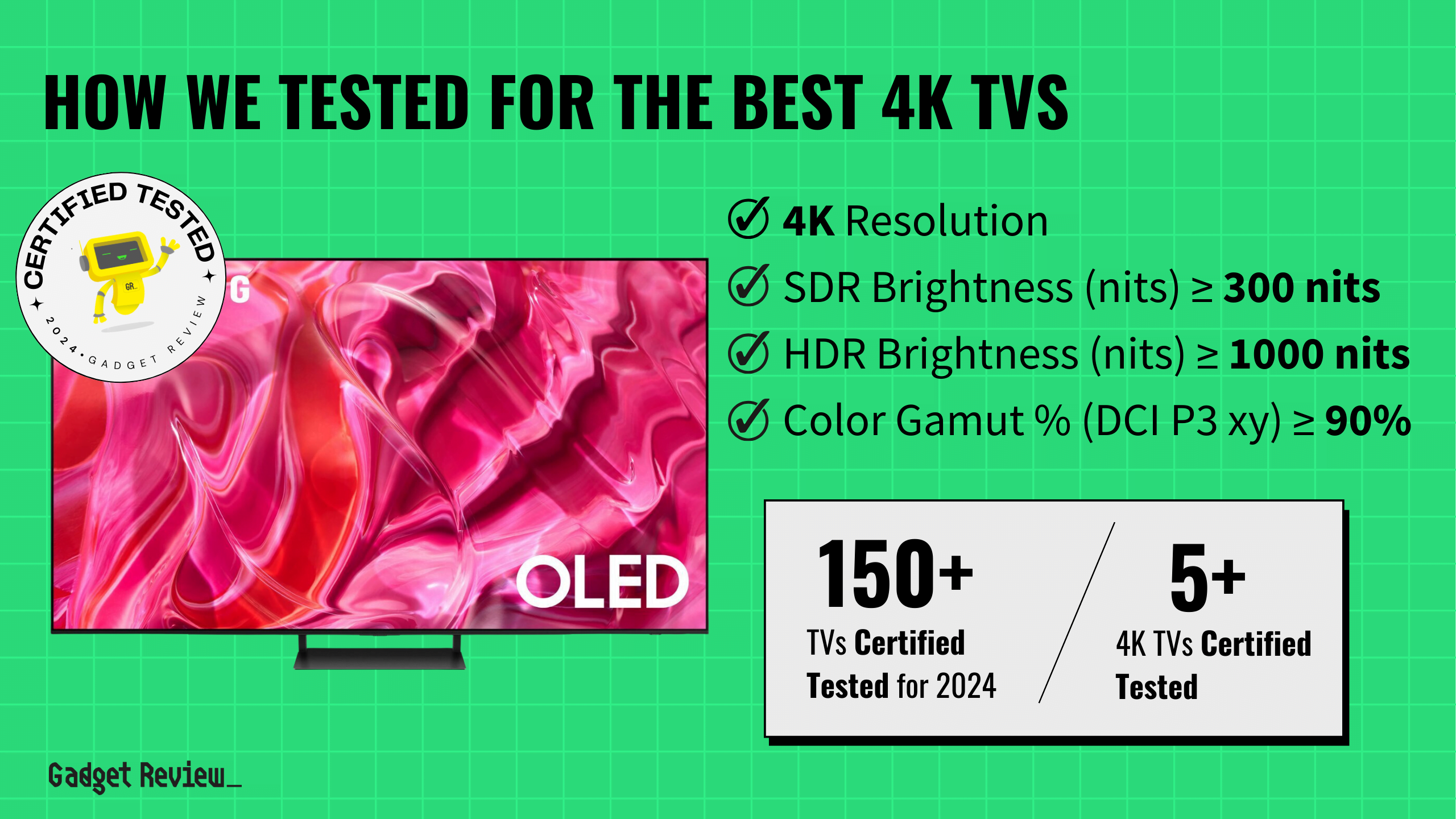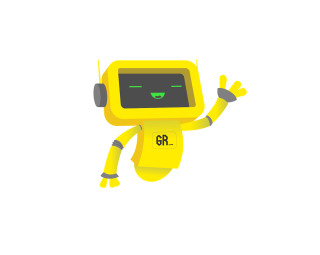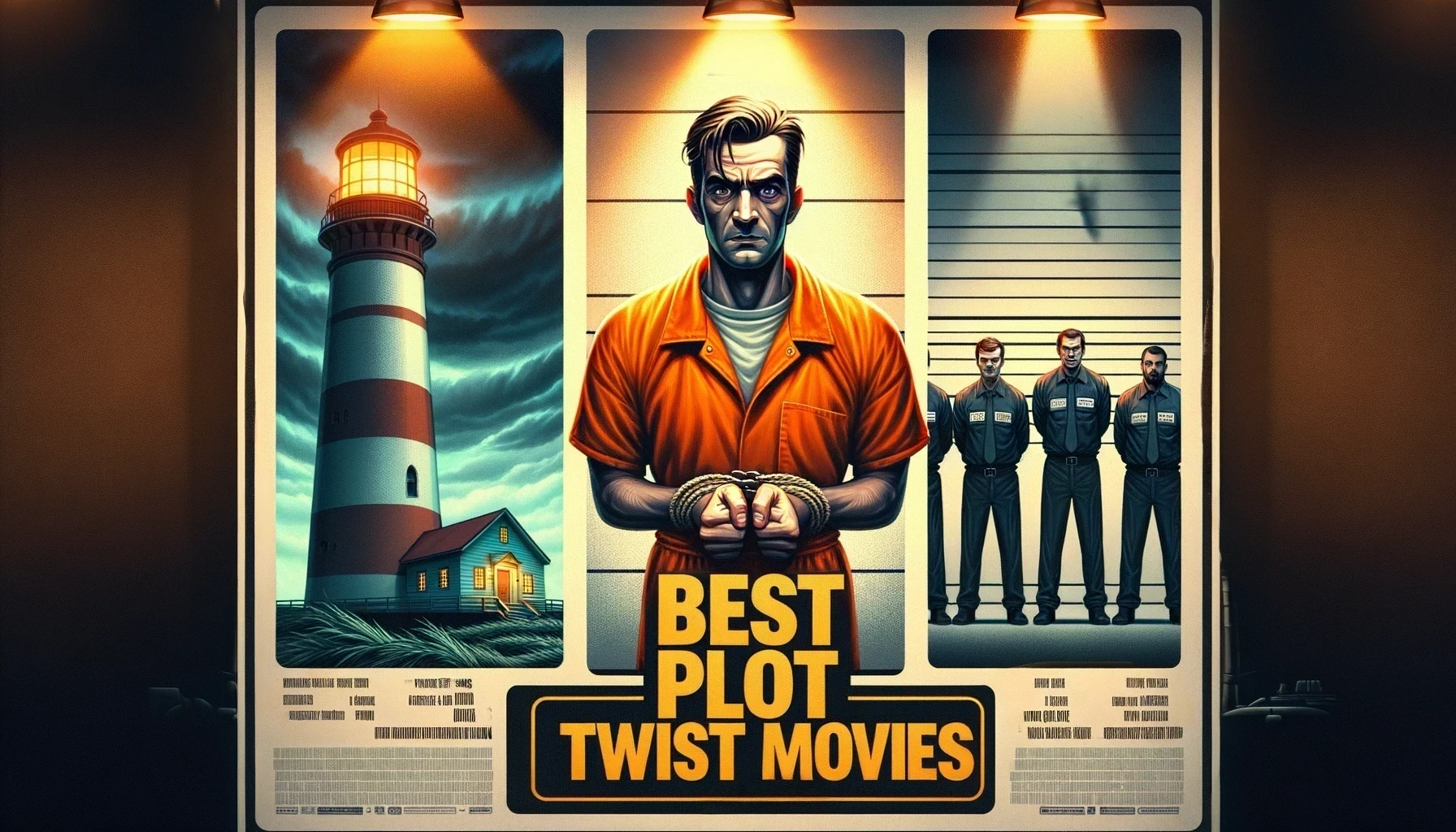If you’re looking for the best 4K TV, then you want to read product reviews by actual experts who have tested numerous 4K TVs in all price ranges – not fake reviews pushing you to purchase a TV that will fail you on movie night. That’s why we scour the web and certify 158 TVs as fully tested (or not) and then shortlist the best 4K TVs (BTW, we were shocked to find 87% of TV reviewers are untrustworthy and many are faking their reviews).
The best 4k TV is about striking the perfect balance between breathtaking resolution and the content you love. The main hurdle? Finding a 4K TV that not only boasts crisp, clear images but also keeps up with fast-moving scenes without lag or blur. Plus, you want to make sure it’s got the smarts to stream all your favorite shows and movies in ultra-high definition.
Look for a 4K TV with a high refresh rate, low input lag, and solid brightness to really make those visuals pop. When it comes to the best TV for your needs, don’t forget about a seamless streaming interface to easily navigate through your content. Got specifics in mind or need a bit more guidance? Let’s dive into the details together.
How Did We Rank the Best 4K TVs?
To assess how high or low quality a TV actually is for 4K content, one must evaluate specific testing criteria against reference industry standards. Using our thorough TV Testing Methodology, we determined there are 1 minimum specs and 6 criteria below (3 required, 3 nice to have) that ensure your 4K content looks as good as the creator intended it.
- Minimum Specifications
- Resolution: 4K, providing unparalleled clarity and detail.
- Test Criteria
- SDR Brightness: Equal to or greater than 300 nits, ensuring a bright and clear picture in any lighting condition.
- HDR Brightness: 1000 nits or more, revealing intricate details in high dynamic range content.
- Color Accuracy: At least 90%, delivering rich and vibrant colors.
- “Nice To Haves”
- Contrast Ratio: 10,000 or higher, offering deep blacks and bright whites for an exceptional viewing experience.
- EOTF Accuracy: Delta E less than or equal to 0.018, for precise brightness and contrast across the board.
- Fast Response Time: 10ms or less, ensuring smooth transitions without motion blur.
We’ve redefined TV buying guides, setting us apart from any other site. Our unique approach combines in-house verification with a comprehensive dataset from over 200+ trusted sites, focusing on key testing metrics to rank the top-rated 4K TVs. Our commitment to unbiased reviews is powered by our ‘True Score’ system, targeting low quality and fake reviews. Commissions fund this mission. No bias. No BS.
Latest Updates
- 03/05/2024: Completely and thoroughly overhauled the guide to include the best and latest 4K TVs.
- 11/30/2023: Republished the list to include TVs based on our True Score system.
Top 4K TVs For 2025
Prices accurate at the time of publishing
For our list, a 4K TV must have 300+ nits brightness, 1000+ nits HDR, and 90%+ DCI P3 color gamut. If it doesn’t check these boxes, it’s out!

Best Overall

Runner Up

Best Value

Best Budget

Best Mid-Range

Premium Pick
Samsung S90C TV
Best For Gaming
The Samsung S90C is a fantastic choice for diverse entertainment needs, excelling in gaming, sports, and cinematic viewing with its high brightness, low reflectivity, and superior color gamut.
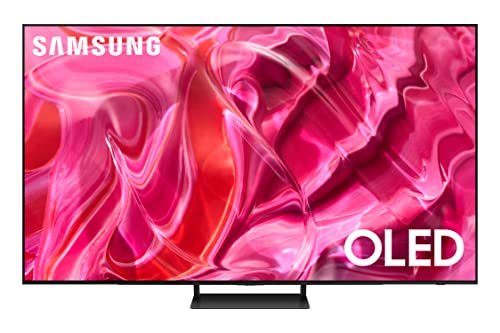
True Score
91948Experts
935kCustomers
Cosmic Wonder
 SAVE $500$1,499.99$999.99
SAVE $500$1,499.99$999.99Read More
Snapshot
Reasons to Buy
- Excellent picture quality
- The near-infinite contrast ratio for perfect blacks
- High peak brightness
- Exceptionally wide viewing angle
- Low input lag/Response time
- Sharp upscaling
Reasons to Avoid
- Aggressive Auto Brightness Limiter (ABL)
- No support for DTS or Dolby Vision
Specifications
Display Type OLED Max Resolution 3840 x 2160 (4k) Refresh Rate 120 Hz, 144 Hz Screen size 55", 65", 75", 83" 
Backlight Type n/a HDMI Inputs 4 
HDMI Type HDMI 2.1 HDR Format HDR10+, HLG 
HomeKit Compatible No 
Number of Audio Channels 2.1 
Panel Type OLED 
Smart Platform Tizen 
Speaker Output 40 Watts 
Sync Technology AMD FreeSync Premium 
VRR Yes All Specs
Test Results
SDR Brightness (nits) 373 HDR Brightness (nits) 1,058 Color Gamut % (DCI P3 xy) 99.975 Response Time (ms) 1.4 Color Gamut % (DCI P3 uv) 99.95 Color Gamut % (Rec 2020 xy) 86.37 Color Gamut % (Rec 2020 uv) 91.59 Color Gamut % (sRGB) 0 Color Gamut % (Rec 709) 0 Color Gamut % (BT.2020) 76 Color Gamut % (Adobe RGB) 0 Color Gamut % (BT.709) 0 Contrast Ratio (x:1) 0 Input Lag (ms) 8.5 Color Washout (Degrees) 70 Color Shift (Degrees) 70 Brightness Loss (Degrees) 70 Reflections (%) 1.2 Low-Freq Extension (Hz) 84.76 Freq Response StdDev @ 70db 2.8 Freq Response StdDev @ 80db 3.63 Weighted Total Harmonic Distortion @80db 0.133 Intermodulation Distortion @80db 2.47 EOTF (600 nit delta) 0.0031 EOTF (1000 nit delta) 0.0036 EOTF (4000 nit delta) 0.0024 All Tests
All Retailers
- $999.99$1,500Save $500
Availability
In StockFree Shipping
No - $1,134.95$1,197Save $62
Availability
In StockFree Shipping
No - $1,389.00$2,598Save $1,209
Availability
In StockFree Shipping
No
Our Verdict
The Samsung S90C comes in as one of the best overall choices for anyone looking for a solid 4K TV. With an SDR brightness of 373 nits and HDR brightness at 1058 nits, the S90C has enough brightness to use in dim and moderately lit rooms, and if you’re watching a ton of HDR content, even gets bright enough to use in some brightly lit rooms. This pairs well with its low reflectivity of only 1.2% total light reflected, meaning that glare won’t be a problem – just don’t put the TV in an excessively bright room.
With its 120 Hz refresh rate and support for AMD Free Sync, the S90C is a phenomenal choice for gaming in 4K thanks to its best-in-class response time of 1.4 ms and an input lag of 8.5 ms. Only the S95C has lower input lag, and with such fantastic response times, the S90C is also the perfect choice for sports fans looking to minimize motion blur when watching fast-paced action. The high viewing angle before colors start to wash out also makes the S90C great for big game day parties, with everyone able to crowd around the set without having image quality suffer.
If you’re a home theater enthusiast, the strong HDR brightness performance is backed up by a best-in-class DCI P3 xy color gamut of 99.98% and an excellent EOTF of 0.0031, among the best on the list. Between this and the near-infinite contrast that OLED panels allow for, the S90C is a great choice for watching cinematic content the way it was meant to be seen, with vivid, accurate colors and gamma.
The S90C is positioned to deliver outstanding gaming performance and unbeatable clarity when watching sports, while still remaining capable of tackling any other kind of content you can throw at it. Whether it’s for watching movies, playing games, or enjoying content in moderately lit rooms, the S90C delivers on all fronts, affirming its place as a premium choice without the usual OLED premium price.
Read Less

Best Overall

Runner Up

Best Value

Best Budget

Best Mid-Range

Premium Pick
Samsung S95C OLED TV
Best For Sports
The Samsung S95C OLED offers exceptional brightness, color accuracy, and low input lag for home theater aficionados and gamers alike, but at a premium price.
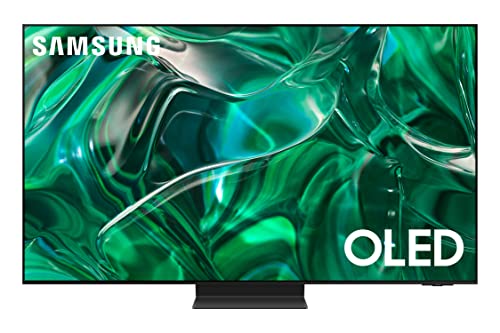
True Score
899215Experts
90723Customers
Absolutely Fresh
 $1,887.95
$1,887.95Read More
Snapshot
Reasons to Buy
- Excellent image quality
- Produces great bright colors and deep blacks
- Exceptionally wide viewing angle
- Incredibly low input lag
Reasons to Avoid
- Aggressive ABL
Specifications
Display Type OLED Max Resolution 3840 x 2160 (4k) Refresh Rate 120 Hz, 144 Hz Screen size 55", 65", 77" 
Backlight Type No HDMI Inputs 4 
HDMI Type HDMI 2.1 HDR Format HDR10+, HLG 
HomeKit Compatible No 
Number of Audio Channels 4.2.2 
Panel Type QD-OLED 
Smart Platform Tizen 
Speaker Output 70 Watts 
Sync Technology AMD FreeSync, AMD FreeSync Premium Pro 
VRR Yes All Specs
Test Results
SDR Brightness (nits) 704 HDR Brightness (nits) 1,383 Color Gamut % (DCI P3 xy) 99.81 Response Time (ms) 5.5 Color Gamut % (DCI P3 uv) 99.53 Color Gamut % (Rec 2020 xy) 84.99 Color Gamut % (Rec 2020 uv) 89.78 Color Gamut % (sRGB) 0 Color Gamut % (Rec 709) 141.5 Color Gamut % (BT.2020) 75 Color Gamut % (Adobe RGB) 0 Color Gamut % (BT.709) 0 Contrast Ratio (x:1) 0 Input Lag (ms) 8.3 Color Washout (Degrees) 70 Color Shift (Degrees) 70 Brightness Loss (Degrees) 70 Reflections (%) 1 Low-Freq Extension (Hz) 106.79 Freq Response StdDev @ 70db 2.45 Freq Response StdDev @ 80db 2.41 Weighted Total Harmonic Distortion @80db 0.511 Intermodulation Distortion @80db 0.511 EOTF (600 nit delta) 0.0029 EOTF (1000 nit delta) 0.0025 EOTF (4000 nit delta) 0.0022 All Tests
All Retailers
- $1,887.95
Availability
In StockFree Shipping
No - $1,899.99$2,300Save $400
Availability
In StockFree Shipping
No
Our Verdict
The Samsung S95C OLED TV earns a strong position on our list thanks to a blend of features that cater to a wide array of preferences. With an SDR brightness of 704 nits and an HDR brightness reaching 1383 nits, the S95C is well-suited for both dim and brightly lit environments. Its ability to display HDR content with strong brightness makes it a versatile choice for various lighting conditions that is further helped along by a best-in-class reflectivity of 1.0% total light reflected, ensuring that glare is minimized across all viewing scenarios.
Like its less expensive brother, the S90C, the S95C also features a 120 Hz refresh rate along with support for AMD FreeSync. It also outperforms the S90C with an input lag of just 8.3 ms, making it a superior option for minimizing delay between inputs and on-screen actions. However, it’s only 0.2 ms faster than its brother, and with a response time of 5.5 ms, the S95C is the slower of the two options for sports enthusiasts. That doesn’t mean it’s bad for sports, quite the contrary, it’s still an excellent and responsive television, and also features a wide viewing angle, making it perfectly well suited for game day parties where everyone crowds around the TV.
If you’re deeply invested in the home theater experience, the S95C does not disappoint. It showcases an excellent DCI P3 xy color gamut of 99.81%, ensuring vivid and accurate color reproduction that barely trails the S90C. Coupled with its OLED panel’s capacity for nearly infinite contrast and a best-in-class EOTF of 0.0029, it delivers cinematic content with unparalleled depth and realism. These features work together to provide an immersive viewing experience, highlighting the S95C as arguably the best choice for home theater enthusiasts seeking the ideal blend of vivid and dynamic images no matter the lighting conditions, accurate colors and near perfect gamma tracking.
While it commands a premium price tag, the Samsung S95C OLED TV excels across a spectrum of uses, from gaming and sports viewing to cinematic enjoyment in any lighting condition. Its combination of high brightness, low reflectivity, expansive color gamut, and excellent EOTF position it as a premium television, particularly for home theater content. If you’ve got room in the budget for a premium OLED experience, the S95C is worth the price of entry.
Read Less

Best Overall

Runner Up

Best Value

Best Budget

Best Mid-Range

Premium Pick
TCL QM8/QM850G QLED TV
Best For Bright Room
Delivers unparalleled brightness and excellent response time, ideal for sports fans and those with brightly lit living spaces, offering great performance at a competitive price.

True Score
85847Experts
90488Customers
Absolutely Fresh
 SAVE $50$999.99$949.99
SAVE $50$999.99$949.99Read More
Snapshot
Reasons to Buy
- Outstanding picture quality
- Spectacular brightness and contrast ratio
- Rapid response time
- Super low input lag
Reasons to Avoid
- Disappointing viewing angles
Specifications
Display Type QLED Max Resolution 3840 x 2160 (4k) Refresh Rate 120 Hz Screen size 65", 75", 85", 98" 
Backlight Type Full-Array 
Depth 11.7" HDMI Inputs (Total) 2 
HDMI Type HDMI 2.1 HDR Format Dolby Vision, HDR10, HDR10+, HLG 
Height 34.1" High Dynamic Range (HDR) Yes 
Number of Audio Channels 3 
Panel Type LED 
Smart Platform Google TV 
Speaker Output 40 Watts 
Sync Technology AMD FreeSync Premium Pro 
VRR Yes 
Voice Assistant Google Assistant 
Weight 54.7 lbs 
Width 56.9" 
Works With Amazon Alexa, Apple HomeKit, Google Assistant All Specs
Test Results
SDR Brightness (nits) 2,076 HDR Brightness (nits) 2,005 Color Gamut % (DCI P3 xy) 94.59 Response Time (ms) 8.9 Color Gamut % (DCI P3 uv) 97.31 Color Gamut % (Rec 2020 xy) 75.81 Color Gamut % (Rec 2020 uv) 80.57 Color Gamut % (sRGB) 0 Color Gamut % (Rec 709) 0 Color Gamut % (BT.2020) 0 Color Gamut % (Adobe RGB) 0 Color Gamut % (BT.709) 0 Contrast Ratio (x:1) 114,057 Input Lag (ms) 14.3 Color Washout (Degrees) 24 Color Shift (Degrees) 31 Brightness Loss (Degrees) 32 Reflections (%) 1.8 Low-Freq Extension (Hz) 89.8 Freq Response StdDev @ 70db 4.74 Freq Response StdDev @ 80db 4.67 Weighted Total Harmonic Distortion @80db 0.128 Intermodulation Distortion @80db 8.67 EOTF (600 nit delta) 0.037 EOTF (1000 nit delta) 0.0238 EOTF (4000 nit delta) 0.0271 All Tests
All Retailers
- $949.99$1,000Save $50
Availability
In StockFree Shipping
No - $998.00$1,136Save $138
Availability
In StockFree Shipping
Yes - $1,299.00
Availability
In StockFree Shipping
Yes
Our Verdict
The TCL QM8/QM850G carves its niche in a very specific way: brightness. Its best-in-class SDR brightness of 2076 nits and HDR brightness of 2005 nits place it at the top for viewers seeking a television that performs exceptionally well in any lighting condition, from the dimmest to the most brightly lit rooms. This high level of brightness, combined with a reflectivity rate of 1.8%, ensures that the TCL QM8 maintains image clarity and reduces glare, enhancing the viewing experience across different environments.
The television supports a 120 Hz refresh rate, indicating smooth motion for dynamic content, which is crucial for both immersive gaming and the enjoyment of fast-paced sports. Its input lag of 14.3 ms, makes it suitable for casual gaming, performing roughly the same as the other LEDs on the list. If you’re looking for the absolute minimum in input lag, however, you may need to pony up for an OLED. On the upside, the TV’s response time of 8.9 ms puts it only a little bit behind the S95C, making the QM8 a great choice for sports fans looking to watch their favorite team in extremely bright rooms.
When it comes to color and contrast performance, the QM8 does well. With a DCI P3 xy color gamut of 94.59%, it ensures vibrant and accurate color reproduction, but its EOTF of 0.0370 means that it has trouble accurately tracking gamma, which will cause problems for home theater enthusiasts looking for the most accurate possible picture. It does have a high contrast ratio of 114,057:1, meaning HDR content will look dynamic, but if you’re looking for accuracy in content above all else and don’t have the budget for an OLED, the Hisense U8K is a better option.
If what matters most to you is raw brightness, then go with the TCL QM8/QM850G QLED TV. It’s a robust 4K TV, offering a compelling mix of high brightness, solid color accuracy, and great response time. Its capabilities make it ideal for sports fans looking to watch TV no matter where they put the set. Bright or dark, the QM8 will handle any ambient light without breaking a sweat, and can do it at a price point that puts it at almost half the cost of an OLED.
Read Less
DID YOU KNOW 87% OF TV REVIEWERS ARE UNTRUSTWORTHY?
Our research found 28 of 210 TV reveiwers can be trusted, and shockingly 1 out of 3 on Google Page 1 were fake reviews showing no proof of test claims. See our Expose and Trust List. This is why Gadget Review is committed to calculating the most accurate product scores on the web.
To do this, we give every TV review site a Trust Rating, which measures how trustworthy the site and their testing claims are. We then leverage AI & a machine learning model to combine and calculate the Trust Rating with data from experts and consumers to deliver the True Score, the web’s most accurate product quality rating.

Best Overall

Runner Up

Best Value

Best Budget

Best Mid-Range

Premium Pick
Hisense U7K
The Hisense U7K offers outstanding value, balancing price with performance in brightness and color accuracy, making it a versatile option for casual viewers and gamers on a budget.
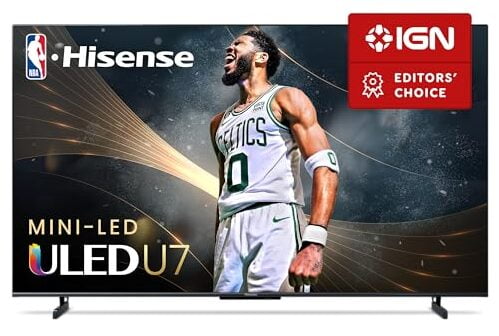
True Score
84859Experts
87777Customers
Absolutely Fresh
 SAVE $40$799.99$759.99
SAVE $40$799.99$759.99Read More
Snapshot
Reasons to Buy
- Outstanding picture quality in the dark
- High peak brightness
- Fast response time and low input lag
- 120 Hz refresh rate
Reasons to Avoid
- Subpar off-center viewing
- Average blooming
Specifications
Display Type LED Max Resolution 3840 x 2160 (4k) Refresh Rate 120 Hz Screen size 55", 65", 75" 
Backlight Type Full-Array HDMI Inputs 4 
HDMI Type 2.0, HDMI 2.1 HDR Format Dolby Vision, HDR10, HDR10+, HLG 
HomeKit Compatible – 
Number of Audio Channels 2.1 
Panel Type IPS 
Smart Platform Google TV 
Speaker Output 40 Watts 
Sync Technology HDR Format 
VRR Yes All Specs
Test Results
SDR Brightness (nits) 603 HDR Brightness (nits) 786.5 Color Gamut % (DCI P3 xy) 96.31 Response Time (ms) 11.3 Color Gamut % (DCI P3 uv) 97.4 Color Gamut % (Rec 2020 xy) 76.18 Color Gamut % (Rec 2020 uv) 81.91 Color Gamut % (sRGB) 98.5 Color Gamut % (Rec 709) 0 Color Gamut % (BT.2020) 76 Color Gamut % (Adobe RGB) 80.5 Color Gamut % (BT.709) 0 Contrast Ratio (x:1) 45,000 Input Lag (ms) 14.3 Color Washout (Degrees) 23 Color Shift (Degrees) 23 Brightness Loss (Degrees) 35 Reflections (%) 1.9 Low-Freq Extension (Hz) 89.8 Freq Response StdDev @ 70db 4.36 Freq Response StdDev @ 80db 4.48 Weighted Total Harmonic Distortion @80db 0.096 Intermodulation Distortion @80db 4.47 EOTF (600 nit delta) 0.0211 EOTF (1000 nit delta) 0.021 EOTF (4000 nit delta) 0.013 All Tests
All Retailers
- $759.99$800Save $40
Availability
In StockFree Shipping
No - $800.00
Availability
In StockFree Shipping
No - $1,008.32
Availability
In StockFree Shipping
No
Our Verdict
If you’re on a budget and need a 4K that will still perform well without making a ton of compromises, the U7K may be exactly what you’re looking for. While its SDR brightness of 603 nits and an HDR brightness of 786.5 nits are the lowest of the LEDs on our list, it’s still bright enough for use in both dimly lit environments and rooms with moderate lighting. Its reflectivity rate isn’t bad either, at 1.9%, but given that the U7K can’t compete with other TVs in bright rooms, this is less useful.
It still has a 120 Hz refresh rate, which means the U7K promises a smooth visual experience, essential for both immersive gaming sessions and enjoying fast-paced sports action. Although it doesn’t boast the lowest input lag in its class, with a figure of 14.3 ms, it still offers responsive performance for casual gaming. With a response time of 11.3 ms, it’s also not bad for sports, and actually performs better than its “big brother”, the U8K, ensuring minimal motion blur and keeping the action crisp.
Color reproduction on the U7K is actually quite good too, with a DCI P3 xy color gamut of 96.31%, ensuring that colors are vibrant and true to life. However, the U7K does struggle with EOTF, coming in at a 0.0211, meaning it’s less suited to accurately tracking gamma in dynamic scenes. If the most accurate possible mastering is what you’re after without shelling out for OLED prices, the U8K will probably serve you better. If you’re a more casual viewer, however, the U7K is cheaper than its brother and less than half the cost of an OLED.
Overall, the U7K is a solid, budget choice for those seeking a versatile 4K television that balances quality with value. As the Best Value TV on our list, its low cost along with its performance in brightness, color accuracy, and responsiveness makes it an excellent choice for someone who enjoys a little bit of everything with their TV. It may not lead the back in any one metric, but it does lead in value, and it lags only slightly behind other options on our list for it.
Read Less

DON’T SEE WHAT YOU’RE LOOKING FOR?
When it comes to home entertainment, don’t just focus on the best TV brands, consider your specific needs. For passionate gamers or sports fans seeking displays that capture the dynamic action and rich colors of live events, there’s an ideal TV tailored to every preference with our guides to the best gaming TVs and top TVs for sports. Or, for those who prioritize picture quality above all, the best OLED TVs are known for their deep blacks and stunning contrast, making every scene pop.
Meanwhile, if versatility is key in your household, the best TV monitors can bridge the gap between work and play. And to complete your home cinema setup, knowing how to connect a soundbar to your TV can transform your audio experience, ensuring you’re not just watching but truly feeling every moment.

Best Overall

Runner Up

Best Value

Best Budget

Best Mid-Range

Premium Pick
Hisense U8K TV
Best For Home Theater
The Hisense U8K is a mid-range powerhouse, offering vibrant colors and exceptional brightness suitable for any lighting condition, making it a top pick for 4K movie lovers.
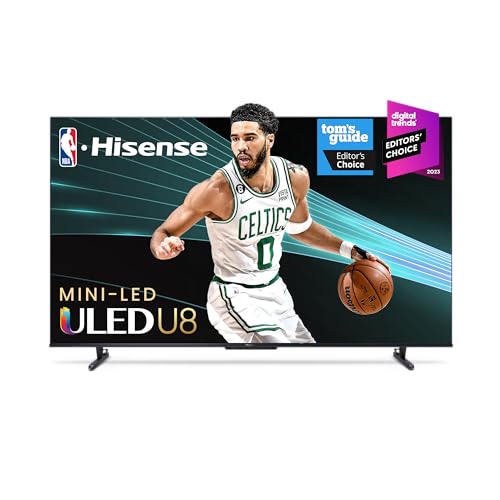
True Score
79796Experts
831kCustomers
Mixed Reviews
 SAVE $150$999.99$849.99
SAVE $150$999.99$849.99Read More
Snapshot
Reasons to Buy
- Good picture quality
- Outstanding brightness and good contrast ratio
- Quick response time
- Great reflection handling
Reasons to Avoid
- Poor viewing angles
Specifications
Display Type LED Max Resolution 3840 x 2160 (4k) Refresh Rate 144 Hz Screen size 100", 55", 65", 75", 85" 
Backlight Type Full-Array 
Depth 3" HDMI Inputs (Total) 4 
HDMI Type HDMI 2.1 HDR Format Dolby Vision, HDR10, HDR10+, HLG 
Height 33.1" High Dynamic Range (HDR) Yes 
Number of Audio Channels 2.1.2 
Panel Type VA 
Smart Platform Google TV 
Speaker Output 50 Watts 
Voice Assistant Google Assistant 
Weight 56.4" lbs 
Width 57.2" 
Works With Google Assistant All Specs
Test Results
SDR Brightness (nits) 1,549 HDR Brightness (nits) 1,792 Color Gamut % (DCI P3 xy) 97.44 Response Time (ms) 13.3 Color Gamut % (DCI P3 uv) 97.01 Color Gamut % (Rec 2020 xy) 76.18 Color Gamut % (Rec 2020 uv) 81.82 Color Gamut % (sRGB) 0 Color Gamut % (Rec 709) 0 Color Gamut % (BT.2020) 80 Color Gamut % (Adobe RGB) 0 Color Gamut % (BT.709) 0 Contrast Ratio (x:1) 165,360 Input Lag (ms) 14.2 Color Washout (Degrees) 23 Color Shift (Degrees) 23 Brightness Loss (Degrees) 35 Reflections (%) 1.8 Low-Freq Extension (Hz) 80 Freq Response StdDev @ 70db 2.06 Freq Response StdDev @ 80db 2.11 Weighted Total Harmonic Distortion @80db 0.1 Intermodulation Distortion @80db 0.71 EOTF (600 nit delta) 0.0105 EOTF (1000 nit delta) 0.0106 EOTF (4000 nit delta) 0.011 All Tests
All Retailers
- $849.99$1,000Save $150
Availability
In StockFree Shipping
No - $997.99
Availability
In StockFree Shipping
No - $1,450.40
Availability
In StockFree Shipping
No
Our Verdict
If you’re looking for home theater performance on a more mid-range budget, the Hisense U8K may be what you need. Its SDR brightness peaks at an impressive 1549 nits, while its HDR brightness manages a very bright 1792 nits, meaning the U8K can perform in just about any lighting condition short of rooms getting direct sunlight nonstop. This high level of brightness, paired with a reflectivity rate of 1.8%, ensures that the U8K combats glare effectively, making it a great choice for any home theater that lets in a lot of natural light.
If you’re more interested in sports and gaming, however, the U8K’s less attractive. A response time of 13.3 ms, combined with an input lag of 14.2 ms, still make it a viable option for gamers and sports fans, but there are better options available, particularly for competitive gamers looking to minimize the delay between their inputs and the game as much as possible. Still, casual gamers will find the input lag to be perfectly acceptable, and the response is fast enough to keep action from getting blurry.
Where the U8K shines in the home theater domain, boasting a DCI P3 xy color gamut of 97.44%, which, while not the highest, still guarantees vibrant and true-to-life colors and is overall the best option outside of springing for an OLED. Between the high brightness and strong EOTF performance of 0.0105, the U8K is a great option for 4K movie lovers. Its excellent contrast ratio (165,360:1) also helps, and while it’s not the infinite that OLEDs are known for, it’s still exceptional for an LED TV.
Great performance in bright rooms with a focus on home theater is what sets the Hisense U8K TV apart from the other 4K LED TVs on our list. Its superior brightness – while not the absolute highest on the list – make it suitable for any lighting environment, while its color gamut and response times ensure a quality viewing experience whether you’re gaming, watching sports, or indulging in cinematic content.
Read Less
Category Snapshot
TVs
- Total Brands/Products Tested
17 Brands, 158 Products
- Top 2 Brands
LG, Hisense
- Price Range (Budget-Premium)
$400-$2000
- Average True Score
76.65
- Important Test Criteria
Brightness (cd/m2)
Contrast Ratio (1000:1) - Most Trusted Testers

- Top TV Experts
- Recommended Retailer

- Typical Warranty
1 year
- Covered by Insurance
Yes – AKKO
- Test Methodology

Our Approach to Testing 4K TVs
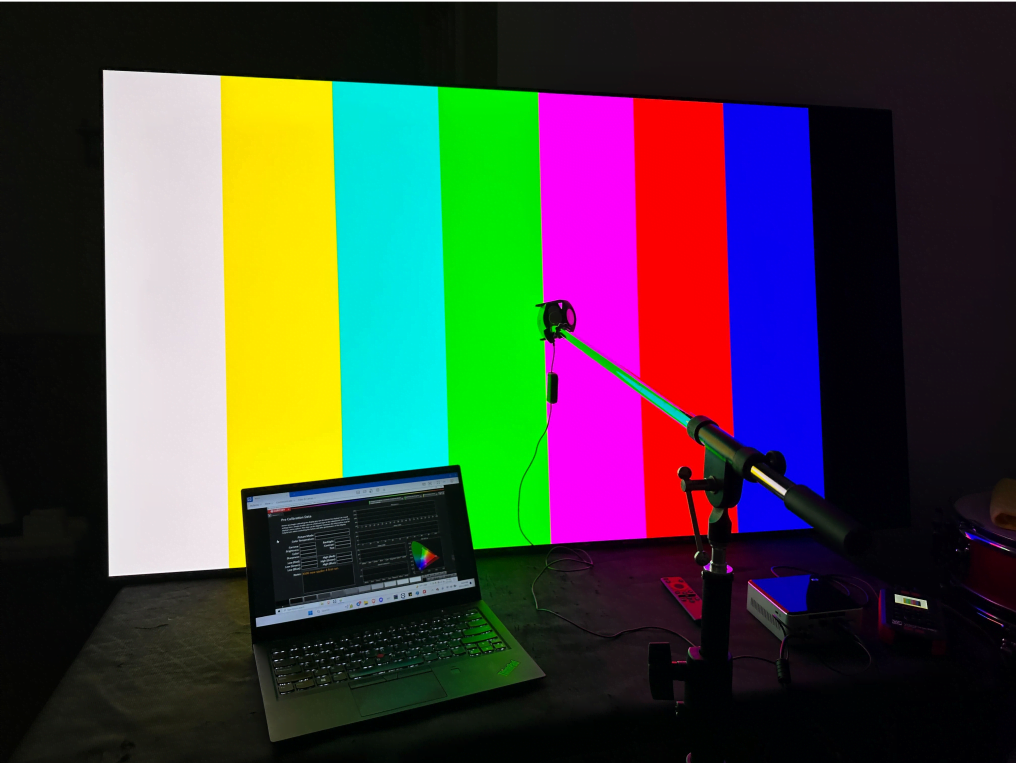
Evan Shepard/Gadget Review
We’ve redefined TV buying guides, setting us apart from any other site on the planet. Our unique approach combines in-house verification with a comprehensive dataset from trusted sites, focusing on key testing metrics like brightness (SDR and HDR), EOTF, response time, contrast ratio and color gamut.
We aggregate and analyze this data, ensuring our recommendations meet the specific needs. Specifically, when it comes to 4K TVs, this involves selecting models that deliver optimal image quality for content up to 4K resolution, including the ability to upscale lower-resolution content effectively. Discover our data-driven methodology for precise, reliable TV recommendations.
You may notice some of our graphs contain “Source: RTings”. This is to indicate that the data we’re showing off in a graph has come from a single source – because it’s the only source that actually tested the criteria and had data for it! Normally, our data is an average out of all of the various publications that test and provide data to give you a good idea of how a product is going to perform on average.
Which Criteria Matter for Testing 4K TVs?
By focusing on these criteria (3 required, 3 nice to have), anyone can quickly and easily compare these TVs and how they’ll perform. This helps you make an informed decision and purchase a TV that will provide you with 4K resolution.
| CRITERIA | RANGE | REQUIRED | DEFINITION |
|---|---|---|---|
| SDR Brightness | 300+ nits | Yes | Assess the luminance of your display when operating in Standard Dynamic Range (SDR) mode. |
| HDR Brightness | 1000+ nits | Yes | Determine the luminance of your display in High Dynamic Range (HDR) mode. |
| Color Gamut (DCI P3 xy) | >= 90% | Yes | Evaluate the extent to which a TV can reproduce a specified spectrum of colors. |
| EOTF | 0.018 | No (nice to have) | Standard that governs how a display interprets and renders brightness and color. |
| Response Time | <=10ms | No (nice to have) | Time required for a pixel to transition from one color to another and then return to its original color. |
| Contrast Ratio | >= 10,000 | No (nice to have) | The ratio between the brightest white and darkest black that the screen can display. |
Our Trusted Data Sources
(Publication category Score is 80%+)
We looked at 210+ TV reviewers and while 24 are trustworthy (60%+ Trust Rating), we only use data from the testers that are “very trusted” which means a Trust Rating above 70%. The three we have listed below are our most trusted for TVs, along with our own in-house TV expert.
- Evan Shepard – Gadget Review
- Matthew Lopes – RTings, MuckRack
- Will Greenwald – PCMag, MuckRack, Twitter
- David Katzmaier – CNET, MuckRack, Twitter
Interested in a comprehensive analysis of our data sources? We’ve got you covered. Below, you’ll find a detailed list of every TV review website we’ve identified, organized by their respective Trust Ratings from highest to lowest. But we didn’t stop there. We’ve meticulously reviewed each publication and verified the data by checking whether the authors have bio links to MuckRack or LinkedIn. We’re committed to not only checking the facts but ensuring their veracity.
TV Test Data & Results
1. SDR & HDR Brightness Test Results
In brighter rooms, your 4K TV’s brightness, measured in nits, matters most for a top-notch viewing experience. If your TV falls short on brightness, it’ll struggle against natural and artificial light, resulting in a dim and less vibrant picture. Essentially, nits gauge how well your TV handles light interference, with higher values ensuring a sharper, more vivid display.
For the best 4K TV experience, aim for a minimum of 300 nits for standard dynamic range (SDR) content to strike the right balance between clarity and color quality. For richer colors and greater contrast in high dynamic range (HDR) content, opt for at least 1000 nits to truly immerse yourself in enhanced visuals. These brightness levels guarantee optimal performance in bright settings, ensuring you don’t miss out on any detail or quality. Remember: SDR Brightness >= 300 nits; HDR Brightness >= 1000 nits for the ultimate viewing pleasure.
Discover the top 4K TVs, ranked from brightest to least.
Brightness
SDR: 300+ nits
HDR: 1000+ nits
Acceptable range of performance
Definition: Maximum brightness in a specified pattern size window. Most commonly measured in a 10% or 100% white window.
Units of Measurement: nits (alternatively cd/m²)
Tools to Measure: TV, luminance meter
Why It’s Important:
Brightness helps counter ambient light so that details and colors don’t wash out and get lost.
SDR Brightness (in nits, higher is better)
HDR Brightness (in nits, higher is better)
2. Color Gamut (DCI P3 xy) Test Results
Color Gamut
>= 90%
Acceptable range of performance
Definition: The TV’s capability to display a spectrum of colors.
Units of Measurement: % (color space coverage in percent)
Tools to Measure: Colorimeter
Why It’s Important:
Inaccurate colors compromise the authenticity of the content.

Color gamut determines the variety of colors a 4K TV can show, directly impacting how lifelike and vibrant your images appear. A broad color range in a 4K TV means richer, more vivid colors, making everything from nature scenes to animated characters pop with realism.
Measured against standards like DCI P3 xy, a higher coverage of this color space means more accurate and vivid colors. For those craving immersive visuals in a 4K TV, aim for a color gamut of 90% or higher on the DCI P3 xy scale. This ensures your content looks as vibrant and true-to-life as possible, delivering a big-screen experience on a smaller scale. Remember: Color Gamut >= 90% DCI P3 xy for the best viewing pleasure.
There is also color range differences when considering screen technology, such as QLED vs LED. QLED TVs often provide a wider color gamut and brighter colors, enhancing the overall viewing experience.
Below are the top 4K TVs, ordered by color gamut, all exceeding our testing criteria.
DCI P3 XY Color Gamut (as a %; high is better)
3. EOTF Test Results
The Electro-Optical Transfer Function (EOTF) is crucial for ensuring your 4K TV displays content just as the creator intended. This technical feature adjusts brightness levels, ensuring each scene, from shadows to highlights, appears true to life.
In well-lit rooms, a 4K TV with precise EOTF calibration maintains contrast and detail despite challenging lighting, keeping images vibrant and detailed. Opting for a TV with superior EOTF management guarantees an immersive viewing experience, accurately rendering scenes with proper light and dark levels, regardless of room lighting. Remember: Aim for EOTF calibration that delivers consistent, realistic pictures with the full spectrum of colors and contrasts.
Below are all the 4K TVs on our list, ordered by EOTF.
EOTF
< 0.018 (600 nit Δ)
Acceptable range of performance
Definition: How your TV interprets and renders the luminance data from content and translates it to be represented on screen. If EOTF/Gamma tracking is too low or too high, it will result in an over-brightened or over-darkened image from reference.
Units of Measurement: this test measures for the delta from the standard
Tools to Measure: Luminance colorimeter
Why It’s Important:
EOTF ensures that the game is displayed (color and HDR brightness) as the creator intended it
EOTF (source: rtings.com – 0 = no data exists; lower is better)
4. Response Time Test Results
Response Time
1ms-10ms
Acceptable range of performance
Definition: Speed at which a pixel transitions from one color to another
Units of Measurement: milliseconds (ms)
Tools to Measure: Screen, camera, test software
Why It’s Important:
A faster response time means less blur and thus more accuracy
A slower response time on your 4K TV during fast-paced scenes can ruin the viewing experience, akin to watching a thrilling movie through a foggy lens. Instead of crisp detail, swift movements become a blur, detracting from the excitement and immersion.
Response time measures how quickly pixels change colors, crucial for enjoying dynamic content on a 4K TV. Opt for a response time of 15 ms or lower for smooth transitions, but if gaming is your thing, aim for 10 ms or lower. This ensures your 4K TV delivers sharp visuals without distracting blurs or delays. For gamers, the best gaming TVs go beyond just low response times, incorporating features like variable refresh rates and low input lag to enhance playability. Remember: Response Time <= 10ms for the ultimate viewing and gaming experience.
Below are the top 4K TVs, ordered by response time.
Response Time (in milliseconds; lower is better)
5. Contrast Ratio Test Results
For 4K TV buffs, a strong contrast ratio is key for enjoying movies or shows, especially in darker settings. It determines how vivid and lifelike your screen’s picture appears, ensuring dark scenes show clear blacks instead of murky grays and bright scenes retain detail without looking washed out.
In simple terms, contrast ratio reflects a TV’s ability to produce a wide range of brightness, from deep blacks to bright whites, adding depth and realism to every scene. When watching in the dark, a high contrast ratio shines, delivering true black for immersive night scenes. Aim for a contrast ratio of 10,000:1 in a small TV for optimal picture quality, ensuring your viewing experience is rich and captivating. Remember: Contrast Ratio >= 10,000:1 for the best visuals.
Below are the top 4K TVs, ordered by contrast ratio, all exceeding our testing criteria.
Contrast Ratio
>=10,000:1
Acceptable range of performance
Definition: Difference between the darkest black and the brightest white a screen can display.
Units of Measurement: cd/m2
Tools to Measure: Luminance meter
Why It’s Important:
A higher contrast ratio delivers deeper blacks, enhancing content definition, especially in darker rooms.
Contrast Ratio (0 = inf, otherwise higher is better)
4K TVs: Mistakes To Avoid
- Ignoring Viewing Distance: Not considering the viewing distance from the TV can lead to either an uncomfortably large or small screen. It’s essential you choose a screen size suitable for your viewing distance to ensure an immersive experience without strain. Moreover, understanding screen sizes, like how wide a 65-inch TV is can assist in ensuring your space is adequately prepared for an immersive experience, with this size being a popular choice for balancing size and performance.
- Overlooking HDR Support: High Dynamic Range (HDR) greatly enhances picture quality by providing a broader range of colors and contrast. Some consumers overlook HDR capabilities, missing out on the full potential of their 4K TV’s display. The best 70-inch TVs will offer stunning 4K resolution and advanced HDR support, ensuring that you’re not missing out on the incredible depth and realism that HDR brings to your favorite content.
- Focusing Only on Resolution: While resolution is important and essential for sharp images, it’s not the sole factor determining picture quality. You can also learn about the differences between 4K vs 8K and consider the best 8K TVs, but remember to not only focus on the resolution. Neglecting other aspects like color accuracy, contrast ratio, and refresh rate can result in a subpar viewing experience. Understanding what a 4K TV is beyond just resolution, including its smart features and how it handles different content types, should be considered to make an informed purchase.
- Forgetting About Smart Features: Many modern 4K TVs come with smart features like built-in streaming apps and voice control. Overlooking these features may mean missing out on convenient and streamlined entertainment options.
The Best 4K TV Tests Compared
Product |
True Score
|
SDR Brightness
|
HDR Barightness
|
Color Gamut
|
Response Time
|
EOTF
|
Contrast Ratio
| |
|---|---|---|---|---|---|---|---|---|
| 91 |
|
|
|
|
|
| $999.99 $1,500 $500 |
| 89 |
|
|
|
|
|
| $1,887.95 |
| 85 |
|
|
|
|
|
| $949.99 $1,000 $50 |
| 84 |
|
|
|
|
|
| $759.99 $800 $40 |
| 79 |
|
|
|
|
|
| $849.99 $1,000 $150 |


